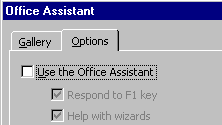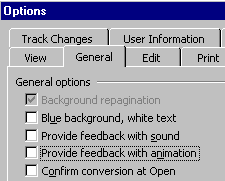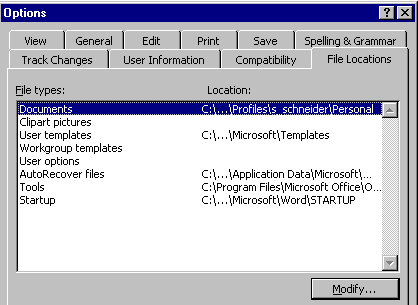Customizing Word (97/2000) with the "Schneider
Options"
Updated : 1/24/2001
These are the customizations that I make for Word - you
can pick and choose which ones you wish to use. These are mostly geared to
the laptop version, but, for faculty, these many also apply to the desktop
computers in our offices.
|
First - Get rid of the Paperclip (Office
Assistant)!!! (Desktop/Laptop)
I choose to remove the paperclip animation - I find it intrusive
and annoying .. your mileage may vary. You should take a look at it if
you haven't seen it though, you might find it useful if you are not as
comfortable with Word. Once you become a "Power User" - you
will want to get rid of it!
Here are the steps :
A) If the Office Assistant (paperclip) is not already showing,
go to the HELP menu and select "Show the Office Assistant".
B) Right click on the Paperclip and select OPTIONS.
C) Uncheck the Use the Office Assistant! (Whew!)
D) Just to be safe - go to the TOOLS > OPTIONS > GENERAL
tab and uncheck the "Provide feedback with animation"
choice.
E) [Turning the Assistant off in step B will take care of the
other Office prog]rams, but in Excel, you will have to go to Tools >
Options > Edit to uncheck the "Provide feedback with animation".
|


|
|
Where are all the menu items and toolbars that
I'm used to seeing? (Laptop only?)
Word 2000 tries to simplify the menus, showing only the most
recently used ones, and a shortened list - I prefer to see all the
items! This will also make the toolbars look more like Word 97.
I would suggest going to the TOOLS menu and go to CUSTOMIZE -
under the OPTIONS tab, uncheck the first two items ("Standard and
Formatting toolbars share one row" and "Menus show recently
used commands first"). Your toolbars and menus should now look "normal"
again! |

|
|
Make WORD2000 compatible with WORD97
(Laptop only, at the moment)
If you have an LTU Techbook, you will have Word2000 on the
laptop, but Word97 on your office computer. Can they talk to each
other? Sort of … here is the easiest way, for the moment, to make
this a smooth transition. Let's limit the Word2000 to the features of
Word97 (many of us, myself included, are barely using all the 97
features anyway!).
Go to the TOOLS menu and select OPTIONS and then the SAVE tab.
At the bottom you should see the choice to "Disable features not
supported by Word 97" - check that box. Now, all the files you
create should be able to be read by Word 97 with no trouble.
|

|
AUTORECOVERY - if WORD or NT Crashes
(Desktop/Laptop)
While we are on that OPTIONS- SAVE tab .. let's make sure that the
AutoRecover is enabled (you can change the time to a shorter time or
longer time if you want). {You can see this on the previous image.}
When this is enabled, if Word crashes before you save a file (or if the
power shuts down) - the next time you load Word, it should bring back what
it had in memory before the crash (it periodically saves to a file). [Make
sure you see the note in the next section about the AutoRecover location
for the Desktop machine.]
E) Modifying AutoRecover directory (DESKTOP ONLY)
While we are at it .. if you set the autorecovery previously, you
should change the location for your desktop computer's AutoRecover
location (the default is to store it on the server itself, but we don't
have the privilege for that .. so it doesn't work!). Change it to a local
drive for you (on the desktop computer, the best place would be the D:
drive (if you have one) - you pick, or create, the subdirectory you want).
Those are most of the crucial changes that I always
make to WORD so that I can use it more productively - if you have any
questions about these steps (or I have made a - gasp - mistake!),
please let me know!!
Return to the Laptop help page
Last Updated =
Friday, 03-Feb-2006 22:34:31 EST
Of
the
210
people that have visited this site, you are the most recent.







